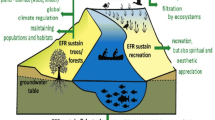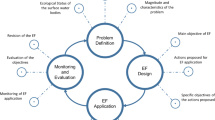Abstract
Stage and discharge monitoring, data analysis, and interpretation are essential for flood control, hydropower operation, navigation, water allocation, and ecological management. In the context of transboundary rivers, hydrometric measurements are crucial to establish and maintain legal regimes of water allocation and operation of hydraulic infrastructures in the basin. In the case of the Nile, where there is no legal regime or prior comprehensive agreement, there is serious need for accurate data for negotiation and establishment of such legal regimes. Quality of stream flow data is dependent on who does the stream gauging, method of stream gauging, data acquisition, data transfer, and data storage. Long-term historical stream flow data is needed to understand basin hydrology, stream flow trend, and changes. Blue Nile stream flow data obtained from different sources are examined in the context of ongoing negotiation of the filling and operation of Grand Ethiopian Renaissance Dam (GERD). The current negotiation is anchored on the data obtained from El Diem Sudan that gives a long-term mean annual flow of 49 billion cubic meters (BCM). Analysis of a set of Blue Nile flow data from different sources and temporal scales indicates significant variation in the data sets. Variability of flow from different records shades doubt on the reliability of using a single series of historical data for long-term negotiation. This paper considers different issues related to flow that affects the GERD negotiation and highlights the importance of accurate streamflow data, instrumentation, and the need for generating new data sets for long-term operation and agreement. The paper stresses the importance of data quality, the type and location of hydrometric measuring stations and the impact of associated data error and measurement inaccuracies in the context of allocation and management of transboundary waters in general terms. Finally, the chapter advises the importance of developing a protocol for upstream and downstream data sharing from all monitoring systems in the basin in a timely manner. An example of limitation of model generated streamflow data is illustrated.
Access this chapter
Tax calculation will be finalised at checkout
Purchases are for personal use only
Similar content being viewed by others
References
Abtew W, Dessu S (2019) The grand Ethiopian Renaissance dam on the Blue Nile River. Springer. https://www.springer.com/la/book/9783319970936
Ahmed Y, Al-Faraj F, Sholtz M (2019) Assessment of upstream human intervention coupled with climate change impact for a transboundary river flow regime: Nile River basin. Water Resour Manage. https://doi.org/10.1007/s11269-019-02256-1
Berhanu B (2014) Chapter 6 Surface water and groundwater resources of Ethiopia: potential and challenges of water resource development. In: Melessse, Abtew, Setegn (eds) Nile River Basin ecohydrological challenges, climate change and hydropolitics. Springer, New York
Buekham DE, Dawdy DE (1970) Error analysis of streamflow data for an alluvial stream, Gila River Phreatophyte Project, Geological Survey Professional Paper 655-C, USGS
Chester CW, Holmes RR, Biedenham DS (2013) Mississippi River streamflow measurement techniques at St. Louis, Missouri. https://doi.org/10.1061/(ASCE)HY.1943-7900.0000752
Corbett DM (1943) Stream gaging procedure a manual describing methods and practices of the Geological Survey. Water Supply Paper 888, USGS
Crowell ML, Mtundu ND (2000) Guidelines for quality control and quality assurance of hydrologic and meteorologic data. Vol. 2: Data management. South Florida Water Management District, West Palm Beach FL
Globalwater.org. USAID. 2019. Providing scientifically robust tools for global water security. https://www.globalwaters.org/GWS-Stories/providing-scientifically-robust-tools-global-water-security
Gonzalez J, Chen Z (2005) Uncertainty of index-velocity measurement culverts. ASCE/EWRI World Water & Environmental Congress. May 14–19, 2005, Anchorage, Alaska, USA
Harmel RD, Cooper RJ, Slade RM, Haney RL, Arnold JG (2006) Cumulative uncertainty in measured streamflow and water quality data for small watersheds. Trans ASABE 49(3):689–701. https://doi.org/10.13031/2013.20488
Heggie J (2020) Can the Colorado River keep on running? https://www.nationalgeographic.com/science/2020/03/partner-content-colorado-river-preserving-stressed-water-resources/
Kinsman G, Kite J, Mtundu D (1994) Guidelines for the collection of hydrologic and meteorologic data. Volume 1: Field applications. South Florida Water Management District
Kunkle GA (2018) Evaluation of the radar stage sensor manufactured by forest technology systems—results of laboratory and field testing. Open-File Report 2017–1085 U.S. Department of the Interior U.S. Geological Survey
MaCnally A, Arsenault K, Kumar S, Shukla S, Peterson P, Wang S, Funk C, Peters-Lidard CD, Verdin JP (2017) A land assimilation system for sub-Saharan Africa food and water security application. Sci Data 4:170012. https://doi.org/10.1038/sdata.2017.12
Mueller DS (2015) Velocity bias induced by flow patterns around ADCPs and associated deployment platforms. https://doi.org/10.1109/CWTM.2015.7098103
Mueller DS (2017) Quantifying acoustic doppler current profiler discharge uncertainty: a Monte Carlo based tool for moving-boat measurements. Water Surv Can. https://doi.org/10.1061/(ASCE)HY.1943-7900.0001249
O’Brien P, Mueller D, Pratt T (2012) Comparison of acoustic doppler current profiler and Price AA mechanical current meter measurements made during the 2011 Mississippi River Flood. https://doi.org/10.1061/9780784412312.127
Oltmann RN (1993) Hydrodynamics of California’s Sacramento-San Joaquin Delta, and the collection of flow data for tracking of pesticides. In: Morganwalp DW, Aronson DA (eds) Proceedings of the technical meeting, vol 2, Colorado Springs, Colorado, September 20–24, pp 695–698
Painter CC, Loving BL (2015) Geological survey quality-assurance plan for surface water activities in Kansas, 2015. Open-File Report 2015–1074, USGS
Ramadan EM, Negm AM, El-Sammny M, El-Sayed AH (2015) Quantifying the impacts of impounding Grand Ethiopian Renaissance Dam on Nasser Lake active storage. Eighteenth International Water Technology Conference. Sharm ElSheikh, 12–14 March 2015
Riverside Technology Inc. (2010) Inception report design of an upgraded data acquisition, communication and flood forecasting systems in the EN countries. Submitted to ENTRO
Sadek N (2006) River Nile flood forecasting and its effect on national projects implementation. Tenth International Water Technology Conference, IWTC102006, Alexandria, Egypt
Samboko HT, Abas I, Luxemburg WMJ, Savenije HHG, Makurira H, Banda K (2020). Evaluation and improvement of remote sensing-based methods for river flow management. Phys Chem Earth 117. https://doi.org/10.1016/j.pce.2020.102839
Sauer VB, Meyer RW (1992) Determination of error in individual discharge measurements. USGS, Open-File Report 92–144
SFEC (2020) Task 3 report: stream gauging and water sediment sampling at four (4) transects and analytical lab results for TSS and TP concentrations (Low Flow Event 12/23/19). Submitted to South Florida Water Management District, West Palm Beach, FL
USGS 2018 Water Resources. USGS Streamgauging Network. USGS.gov
Xiao B, Wan F, Wu CQ, Zhang K (2009) River cross-section surveying using RTK technology: the Yangtze River project case study. Coordinates https://mycoordinates.org/river-cross-section-surveying-using-rtk-technology/all/1/
Zulkafli Z, Buytaert W, Onof C, Lavado W, Guyot JL (2013) A critical assessment of JULES land surface model hydrology for humid tropical environments. Hydrol Earth Syst Sci 17:1113–1132. https://doi.org/10.5194/hess-17-1113-2013
Author information
Authors and Affiliations
Corresponding author
Editor information
Editors and Affiliations
Rights and permissions
Copyright information
© 2021 The Author(s), under exclusive license to Springer Nature Switzerland AG
About this chapter
Cite this chapter
Abtew, W., Moges, S.A., Meles, M., Imru, M. (2021). River Flow Monitoring and Data Quality for Equitable Nile Water Sharing. In: Melesse, A.M., Abtew, W., Moges, S.A. (eds) Nile and Grand Ethiopian Renaissance Dam. Springer Geography. Springer, Cham. https://doi.org/10.1007/978-3-030-76437-1_16
Download citation
DOI: https://doi.org/10.1007/978-3-030-76437-1_16
Published:
Publisher Name: Springer, Cham
Print ISBN: 978-3-030-76436-4
Online ISBN: 978-3-030-76437-1
eBook Packages: Earth and Environmental ScienceEarth and Environmental Science (R0)




